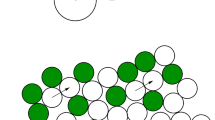Abstract.
We perform traction experiments on viscous liquids highly confined between parallel plates, a geometry known as the probe-tack test in the adhesion community. Direct observation during the experiment coupled to force measurement shows the existence of several mechanisms for releasing the stress: while fingering is favored for low traction velocities, low confinement and low viscosity, nucleation of bubbles occurs in the opposite conditions. It is possible to quantitatively predict the transition between the two regimes and, in many respects, describe the shape of the force response. Using a model for purely viscous fluids, we also present a phase diagram for the different force peak regimes that remarkably accounts for the data. Our results show that conspicuous features of the traction curve commonly thought to be characteristic of soft viscoelastic solids like adhesives are already encountered in liquid materials.
Similar content being viewed by others
References
C. Creton, P. Fabre, in The Mechanics of Adhesion, edited by D.A. Dilliard, A.V. Pocius (Elsevier, Amsterdam, 2002) p. 535.
For a short review on stickiness, see C. Gay, L. Leibler, Phys. Today 52, 48 (1999).
A. Zosel, Colloid Polym. Sci. 263, 541 (1985).
H. Lakrout, P. Sergot, C. Creton, J. Adhes. 69, 307 (1999).
K.R. Shull, C.M. Flanigan, A.J. Crosby, Phys. Rev. Lett. 84, 3057 (2000).
A. Ghatak, M.K. Chaudhury, V. Shenoy, A. Sharma, Phys. Rev. Lett. 85, 4329 (2000).
S. Poivet, F. Nallet, C. Gay, P. Fabre, Europhys. Lett. 62, 244 (2003).
P.G. Saffman, G.I. Taylor, Proc. R. Soc. London, Ser. A 245, 312 (1958).
P. Tordjeman, É. Papon, J.-J. Villenave, J. Polym. Sci. B 38, 1201 (2000).
B.A. Francis, R.G. Horn, J. Appl. Phys. 89, 4167 (2001).
D. Derks, A. Lindner, C. Creton, D. Bonn, J. Appl. Phys. 93, 1557 (2003).
M. Tirumkudulu, W.B. Russel, T.J. Huang, Phys. Fluids 15, 1588 (2003).
A. Roy, S. Roy, A.J. Bhattacharyya, S. Banerjee, S. Tarafdar, Eur. Phys. J. B 12, 1 (1999).
J.J. Bikerman, J. Colloid Sci. 2, 163 (1947).
A. Berker, in The Mechanics of Adhesion, edited by D.A. Dilliard, A.V. Pocius (Elsevier, Amsterdam, 2002) p. 443.
M.J. Shelley, F.-R. Tian, K. Wlodarski, Nonlinearity 10, 1471 (1997).
C. Gay, L. Leibler, Phys. Rev. Lett. 82, 936 (1999).
G. de Crevoisier, PhD Thesis, Université Paris 6 (1999).
Note that, if the indenter is locally spherical (radius R) and entirely immersed in the fluid [10], the differential equation ([5]) becomes \( 6\pi \eta R^2\frac{\dot{h}}{h}=K[V t+h_0-h]. \) Using the following modified compliance\/ and cavitation\/ indices (see Eqs. ([17]) and ([18])) \( C^{\rm JKR}\equiv\frac{\eta\,R^2\,V}{K\,h_0^2}, \qquad \Pi^{\rm JKR}\equiv\frac{\eta\,R\,V}{h_0^2\,\Delta p}, \) Following the same approach as developed in this Section, one obtains exactly the same diagrams as those presented in Figures [19] and [20].
Equation ([19]) has been numerically solved using Maple V, Waterloo Maple Inc.
http://scilabsoft.inria.fr/.
Author information
Authors and Affiliations
Corresponding author
Additional information
Received: 30 July 2004, Published online: 26 October 2004
PACS:
82.35.Gh Polymers on surfaces; adhesion - 47.55.Bx Cavitation - 83.50.Jf Extensional flow and combined shear and extension
Rights and permissions
About this article
Cite this article
Poivet, S., Nallet, F., Gay, C. et al. Force response of a viscous liquid in a probe-tack geometry: Fingering versus cavitation. Eur. Phys. J. E 15, 97–116 (2004). https://doi.org/10.1140/epje/i2004-10040-2
Issue Date:
DOI: https://doi.org/10.1140/epje/i2004-10040-2




